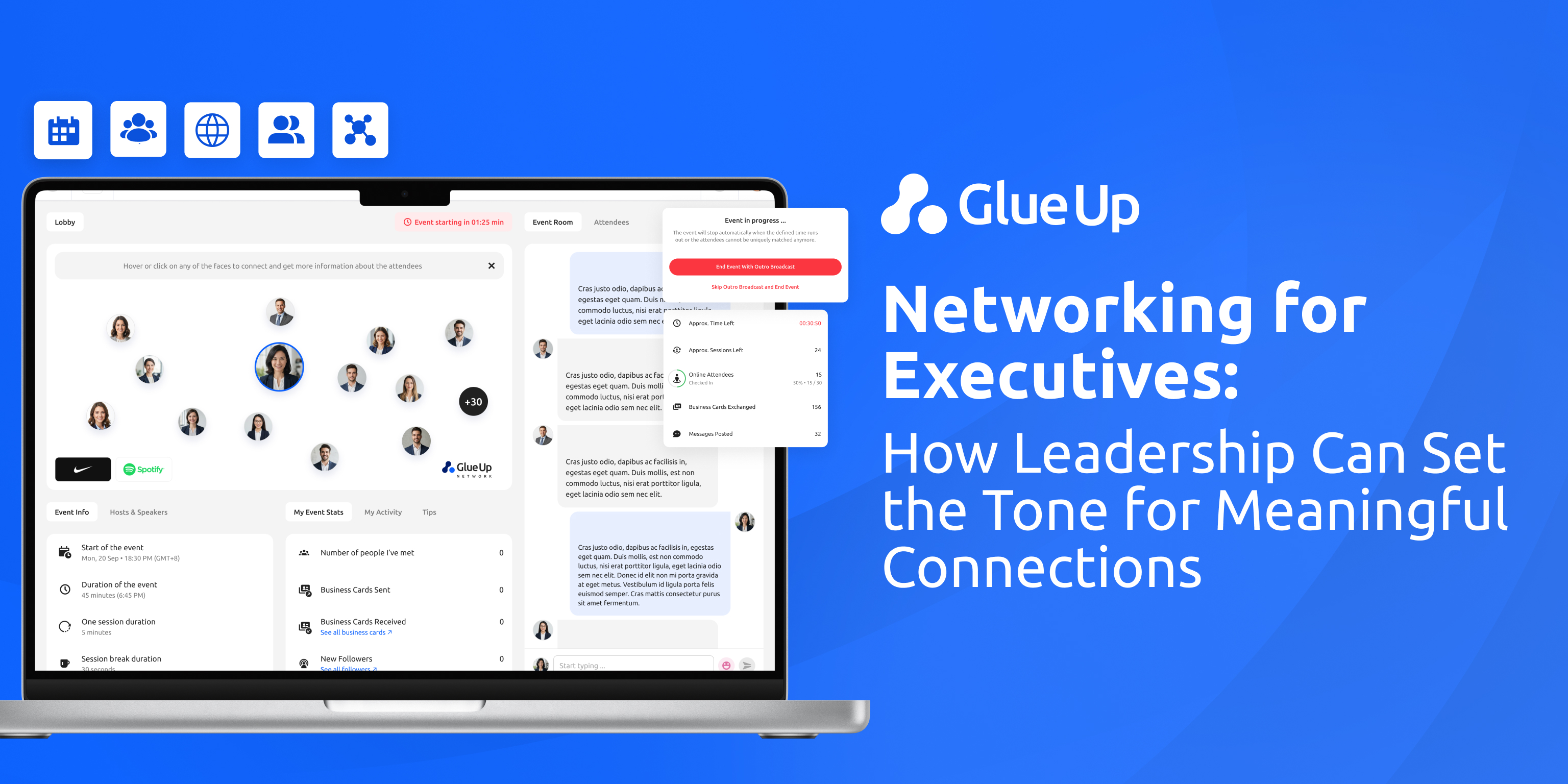
When people talk about executive networking, it often gets flattened into clichés: cocktail hours, golf courses, and conference introductions. But for leaders of associations, chambers, and member-based organizations, executive networking is a leadership discipline that shapes strategy, accelerates growth, and models behaviors that ripple across an entire organization. When a CEO engages meaningfully, everyone in the ecosystem feels the shift: staff, members, partners, and even the industries they serve.
What separates impactful leaders from those who get stuck in surface-level exchanges is a mindset. Networking for executives is designing deliberate systems of connection, creating rituals that sustain them, and measuring the outcomes that truly matter. Associations thrive when their leaders embody it in a way that is strategic, authentic, and scalable.
Glue Up is helping leadership teams map, measure, and magnify their influence. To understand why, we need to look at how CEOs can start conversations, how executive networking plans are designed, how impact is measured, how senior leaders are coached, and how digital tools and events scale these efforts into something much larger than themselves.
Key Takeaways
Executive networking is leadership in action. CEOs and senior leaders set the standard for how their organizations connect, and their approach directly shapes outcomes.
A structured executive networking plan drives impact. Mapping networks, choosing strategic themes, building rituals, and distributing roles ensures focus and prevents overload.
Metrics make networking measurable. Tracking diversity, bridging, and business outcomes transforms networking from vague anecdotes into strategic evidence.
Authenticity sustains executive networking. Coaching leaders to manage time, balance strong and weak ties, and show up meaningfully on digital channels makes relationships last.
Digital platforms scale influence. Glue Up empowers associations to extend executive networking beyond events, turning one-off encounters into ongoing systems of connection and measurable growth.
Best Practices for CEOs To Start Strategic Networking Conversations
For most executives, the hardest part is knowing what to say. Leadership presence creates gravitational pull, but it also carries pressure. If a CEO opens with a generic “So, what do you do?”, they waste the chance to frame the conversation in terms of value, vision, or shared ambition. Strategic networking requires different openers, ones that turn small talk into meaningful dialogue.
Start with purpose. Instead of asking for résumés, frame the conversation around themes that matter to your organization. A CEO at a chamber might ask: “What’s the most pressing challenge for businesses in your sector right now?” A trade association leader might start with: “What’s the one policy change that would unlock growth for you this year?” These show curiosity, authority, and a willingness to bridge perspectives.
Keep it brief, keep it actionable. The best executives respect time. Ten minutes can be enough if the conversation surfaces an actionable insight, creates a warm introduction, or sparks a future collaboration. CEOs should model short, high-value exchanges instead of sprawling, unfocused chats.
Lean into diversity. Most leaders instinctively gravitate toward peers who look, think, or operate like them. The best CEOs consciously move beyond their comfort zones. Diversity in executive networking is an innovation engine. Research consistently shows that diverse networks produce more original ideas and better problem solving.
When leaders initiate conversations this way, they set the tone for everyone else. Staff follow their example. Members notice. And stakeholders begin to see the organization as a living, breathing hub for meaningful connections.
How To Design an Executive Networking Plan for Your Leadership Team
Left to chance, networking becomes scattered. Executives talk to people they already know or accept meetings out of obligation. What’s missing is intentionality. Designing an executive networking plan forces leadership teams to focus on the networks that matter most and create repeatable systems to sustain them.
Understand the three types of networks. Harvard research identifies operational, personal, and strategic networks. Operational networks help leaders execute responsibilities. Personal networks provide professional support. Strategic networks connect leaders to people who shape the future. Most executives over-invest in operational and personal networks because they feel urgent. Strategic networks get neglected because they are the ones that shift industries.
Map the current state. Leadership teams should literally draw their networks: Who do we talk to regularly? Who is missing? Where are the blind spots? This exercise often reveals echo chambers, networks filled with people in the same demographic, geography, or sector.
Choose strategic themes. No CEO can network across every possible issue. The most effective leaders pick two or three themes: innovation, advocacy, partnerships, or global expansion; and focus their networking on those. These themes provide coherence and prevent over-networking.
Build rituals. Networking doesn’t scale without rhythm. Salons, roundtables, and executive office hours create predictable formats where conversations happen without constant reinvention. When Glue Up clients set recurring executive sessions inside the platform, participation rises because people know when and how to engage.
Distribute responsibility. One leader cannot hold all networking weight. By spreading networking roles across the executive team, organizations tap into multiple styles and reach. The CEO might host external roundtables while the COO cultivates industry peers, and the Membership Chair builds cross-sector bridges.
An executive networking plan is a living system. Organizations that design it deliberately create resilience, while those that wing it risk fatigue and missed opportunities.
Metrics To Measure the Impact of Leadership Networking Efforts
Executives often resist quantifying relationships. Networking feels intangible, more art than science. But without metrics, leadership teams default to anecdotes. The problem with anecdotes is that they miss the larger patterns.
Network health metrics. Borrow from social network analysis. Diversity scores measure how varied a leader’s connections are across sectors, geography, and demographics. Brokerage or bridging scores assess whether a leader connects groups who wouldn’t otherwise talk. Leaders who serve as bridges are more valuable than leaders who deepen silos.
Outcome metrics. Every executive networking effort should be tied to business outcomes. Did membership grow after the CEO hosted a salon? Did a sponsor renew after an executive dinner? Did a new partnership emerge after a strategic roundtable? Tracking these outcomes connects soft skills to hard results.
Qualitative wins. Numbers don’t capture everything. Sometimes the most impactful stories are narrative. A CEO might share how a single conversation with a policymaker shifted an entire advocacy campaign. Collecting these stories alongside metrics humanizes the data.
Glue Up enables leaders to do both: track who engaged, how often, across what events, and what results emerged. Its analytics dashboards transform scattered connections into visible patterns of impact. When executives can point to a chart showing how networking improved retention or unlocked partnerships, the board listens differently.
Coaching Senior Leaders to Build Authentic Relationships
The challenge with executive networking is sustaining them authentically. Senior leaders often struggle with time constraints, personal styles, or discomfort in networking-heavy settings. Coaching helps.
Categorize relationships. Encourage leaders to sort contacts into strong ties, weak ties, and dormant ties. Strong ties offer immediate trust but can create echo chambers. Weak ties, people known but not close, often provide the freshest ideas. Dormant ties, once reactivated, can surprise with unexpected opportunities. Coaching leaders to rotate attention across these categories prevents stagnation.
Protect time. Networking collapses when schedules get crowded. Senior leaders should block time specifically for outreach, check-ins, and external conversations. Protecting this time signals that relationships are core to leadership.
Encourage outreach to weak ties. Leaders naturally lean on strong ties, but research shows innovation lives in the periphery. Coaching leaders to reach out to someone they haven’t spoken to in a year often yields surprising breakthroughs.
Model social presence. Authentic digital engagement matters. Senior leaders don’t need to post daily on LinkedIn, but when they do, it should be meaningful: commentary on industry shifts, highlighting member success stories, or amplifying partner voices. Performative posting erodes credibility; thoughtful posting builds it.
Glue Up strengthens this coaching by embedding reminders and prompts into the daily flow. Whether through CRM nudges, community app notifications, or automated follow-ups, the platform helps leaders stay consistent without micromanaging every connection.
Digital Platforms and Events That Scale Executive Networking
For decades, executive networking depended on geography and luck. Who you bumped into at conferences determined your reach. Today, digital platforms extend that reach, but not all platforms are created equal.
Curated executive networks. Groups like Vistage, YPO, Chief, and Pavilion provide structured peer forums. They excel at curated intimacy but operate on exclusivity. Not every association can rely on them to scale leadership influence.
Open digital platforms. LinkedIn offers scale but lacks curation. Leaders can broadcast broadly but struggle to sustain depth.
Owned systems. This is where Glue Up differentiates. Associations using Glue Up create executive salons, digital roundtables, private leadership groups, and curated networking spaces under their own brand. They own the network. With Glue Up, executive networking doesn’t end when an event close, it continues through mobile apps, member directories, and digital business card exchanges.
Events as catalysts. In-person and hybrid events remain vital, but digital extensions multiply their value. A leadership dinner sparks introductions, but Glue Up ensures follow-ups happen through automated reminders, chat tools, and integrated CRM notes. Events are no longer one-off moments; they are accelerators inside a larger networking engine.
By combining digital platforms with structured events, associations turn executive networking from episodic encounters into compounding advantages. Leaders leverage those connections to shape industries.
Conclusion
Executive networking is not about charisma or collecting business cards; it’s about leadership in action. CEOs and senior leaders set the tone for how their organizations connect. When they model curiosity, structure, and authenticity, they transform networking into a strategic lever that drives growth, partnerships, and innovation.
But without design, metrics, coaching, and digital tools, even the most charismatic leader risks falling into surface-level chatter. Associations that thrive are the ones that systematize networking, embed it into leadership practice, and measure its impact.
Glue Up makes this possible. It transforms executive networking from a fuzzy concept into a disciplined system: designed, measured, coached, and scaled. For leaders ready to elevate their influence and deliver measurable outcomes, the path forward is clear: stop treating networking as extracurricular and start treating it as strategy.
See how Glue Up helps your leadership team build meaningful connections that translate into measurable growth. Book a demo today.



